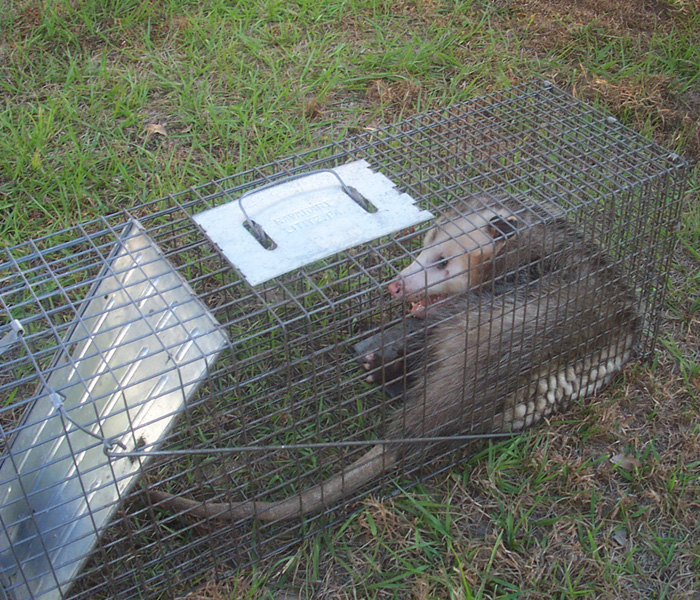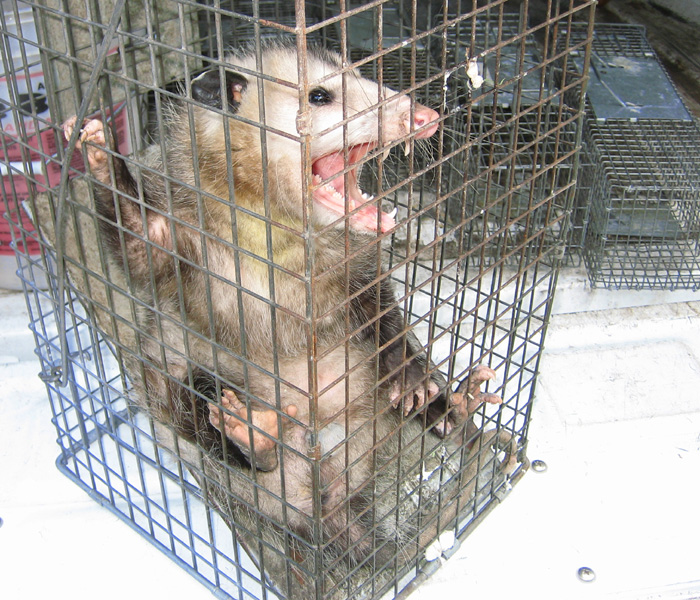- USA Opossum Removal Education Guide and Resources
How to Get Rid of Opossums

HOW TO GET RID OF OPOSSUMS IN THE ATTIC: Yes, this does happen quite frequently (see photo to left and below), and this is a very complex case. This almost always involves an adult female with baby possums. The baby opossums usually cling to their mother, but they drop off one by one as they grow, and it's very common for small ones to rome around in the attic, and fall down walls or other cavities. There they will call out with a kind of chirping call, and if not removed, will die and cause an odor problem. Here are the general steps for removing opossums from an attic.
- Step 1: Inspect the home, and find the entry hole(s), which are very large and obvious.
- Step 2: Enter the attic. If you find the adult female, catch her via snare pole.
- Step 3: Search the attic carefully, and find and remove any baby possums by hand.
- Step 4: If you couldn't find and remove them all (very hard to do), you will have to set traps. This is the only species for which traps in the attic will be successful.
- Step 5: Once they are all out, repair the entry holes with pro-grade repairs.
- Step 6: Clean the attic, removing all feces, and spray with enzyme cleaner.
- Remember: An opossum in the attic often has babies. They must be removed too.

HOW TO GET RID OF OPOSSUMS VIA TRAPPING: Opossum trapping is subject to state laws regarding capture and relocation or euthanization of wildlife. If you have unwanted possums outside the home, in some cases, the only fix is to trap and remove the nuisance wildlife. We can safely, legally, and effectively catch and remove your nuisance opossums. Trapping is an art, and most amateur attempts go awry for a variety of reasons. An intimate knowledge of opossum behavior, both prior to and after trapping, and of various opossum trap types is necessary to ensure that the possum is trapped and removed without incident.
- STEP 1: Determine if trapping is necessary, or if there is a preventative alternative.
- STEP 2: Select the right trap for the situation, there are many types of opossum traps.
- STEP 3: Set the traps in the correct areas, in the shade, camouflaged, on a flat sturdy surface, away from any obstructions or areas that can be damaged, etc.
- STEP 4: Use the correct bait. Don't use meat-based baits, which can attract stray cats.
- STEP 5: Monitor the trap daily, remove trapped opossums & transport them.
Opossum prevention – how to keep opossums away from your house and yard - Opossums are odd creatures that normally grow to the size of your average house cat. Despite the fact that their heritage has been linked to as far back as dinosaur days, it would seem that they haven’t really evolved much, still being classed as wildlife problem or pest, although they do have a few tricks up their sleeves if caught by an angry human, which in all fairness, can often work to the humans advantage!
These critters are resilient, so if you have found one in your yard, you are going to need to remove it and quickly! They eat a lot of different things and are omnivores, just like most of us humans. They can eat anything from plant roots, (which is why they cause such a mess in your yard) fruit, beetles, snails, oranges, other fruits and even eggs. This means that they can survive in the worst of conditions, which unfortunately for you, is not your back yard. In fact, your yard provides them with the perfect home, especially if they want to rear their young, and believe me, when a Mama opossum has babies, she can have a lot! Usually, they will have anywhere in the range of 5 to 25, which as you can imagine, can cause a rather devastating problem.
The thing about these amazing little creatures is that when they feel threatened or harmed, their body takes over and causes them to play dead. This is where they usually come into trouble, as a human will dispose of a “dead” opossum, despite the fact that it is still alive.
When it comes to trying to keep these opossums away from your home and yard, you will find that it can be a difficult task. Of course, you can remove the food source away in the form of not leaving food in the garbage can, cleaning the barbecue so there are no scraps left, not leaving pet food out, etc. but in reality, this will not really solve the problem as they will still scrounge for bugs and snails, as well as roots of your plants, so essentially, they will still have a food source.
The best thing that you can do if you do have an opossum invasion in your yard is to call on a wildlife control company or professional. These guys, (or girls) will know how to deal with the problem effectively, and safely too, so that you, the little critters and the rest of your family are kept safe, as well as eliminating any damage to your poor garden.
There are small things that you can do for yourself for opossum prevention, and one of these is to use chicken wire along the entire outskirts of your yard to try and keep them out. The only problem with this is that it will need to be around four feet high, and if you have a large yard, it can prove to be rather costly. Also, it cannot be supported by anything as the creature will use the support as a sort of stepping stone to get in, which doesn’t really help the problem at all!
ABOUT OPOSSUMS
The Virginia Opossum is the only marsupial animal that resides in North America. This opossum originated from South America, where the climate for marsupials is more favorable, but because this animal is an opportunist is expanded its territory into the United States and now is encroaching upon Canada. As long as there are food sources available, the opossum will continue to spread its territory.
The Virginia Opossum is a funny looking creature that is no bigger than the usual domestic house cat. Its fur is gray, its face is white and it has a long snout with a flat button nose. However, what truly makes this marsupial unique is that it has a prehensile tail and opposable thumbs on its back paws. These features make the Virginia Opossum very successful at carrying its own food and manipulating objects.
Unfortunately, the Virginia Opossum have a very short life span. In the wild the maximum life expectancy is two years and in captivity it is not much longer (roughly about five years). There have been many theories as to why this is possible, and it is generally agreed upon that this animal has such a short life span because the Virginia Opossum has not developed any defense mechanisms to protect itself from natural predators. This animal’s only defense is to “play dead” when it senses danger, but unlike an armadillo, the Virginia Opossum does not have a hard outer shell, so playing dead is not very effective at dissuading predators.
Opossums live wherever there is food available. They can live in habitats that range from forest lands to swamps. They also thrive in rural areas like farmland that is both quiet and abundant with food sources. However, there favorite areas to inhabit are wetlands like marshes and near streams because of the small and diverse animals that are easy to catch and tasty to eat.
Virginia Opossums eat a wide variety of foods depending on where they are and how hungry they are. Opossums are omnivores and will eat plants, nuts, fruits and fungi but will also eat insects, small birds and other small animals. Persimmons are the Virginia Opossum’s favorite food and are an essential staple in their diets. Opossums will also engage in cannibalism if they are desperate for food but this rarely happens in the wild and will only happen in the long barren months of winter. The Virginia Opossum has is slowly but surely invading urban areas because of the easy access to trash. Unfortunately, many opossums get sick or even die choking on paper and plastic.
The Virginia Opossum has very large litters of up to 25 young, but usually has around 8 up to 3 times per year. It is theorized that the opossum has so many babies because their life span is so short, and many of the babies will die within minutes of birth. The mother only has 13 teats and if the young cannot find its way to the teat it dies because it is too small for the mother to see. Opossums have a pouch and the successful babies will climb into the pouch and continue to suckle up to 2 months. After the young leave the pouch, they are still dependent on the mother for another 2 months. The life of a Virginia Opossum is short and brutish, but it has proven to be a contender amongst resilient animals.
Go back to the main Opossum Removal page for more information about how to get rid of opossum.
How To Trap a Opossum - Methods for catching opossum in cage traps.
Opossum in the Attic - Info about what to do if you have opossum in the attic.
How to Kill a Opossum - Does poison work to kill opossum? Is killing opossum the best approach?
Opossum Feces - Pictures of opossum poop and info about danger, and diseases from opossum droppings.
Opossum Prevention - Preventative methods for how to keep opossum away from your property.
Opossum Repellent - Analysis of various opossum deterrents and repellent products.
What Bait Catches Opossum - What kind of food do you put in a trap to catch a opossum?
Opossum on the Roof - If you hear scratching on the roof, and think it's a opossum.
Opossum Under a Shed or Deck - Sometimes opossum will dig under or live under a shed or deck.
Opossum Poison - What are the available types of opossum poison? Are they legal?
Dead Opossum - Removal of a dead opossum in the house or on the property.
Diseases from Opossum - Analysis of what kinds of diseases opossum can carry and cause in humans.
Opossum Urine - Information about opossum pee, and the dangers or diseases of opossum urine.
Baby Opossum - Photos and information about baby opossums.
Opossum in Your House - Tips on how to get a opossum out of hour house.

